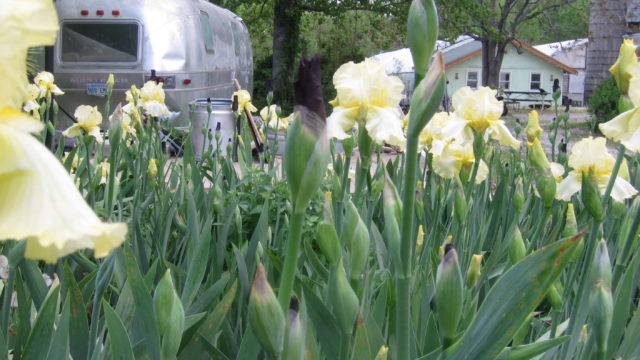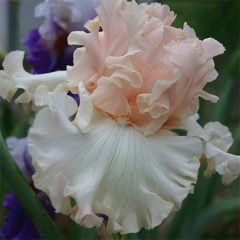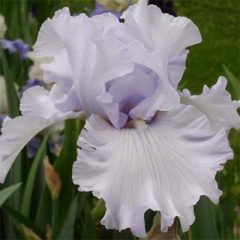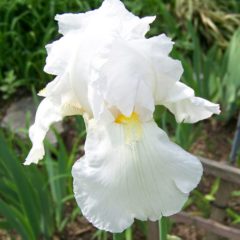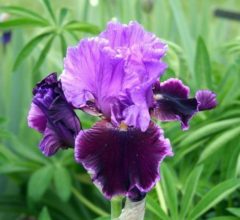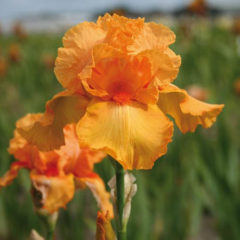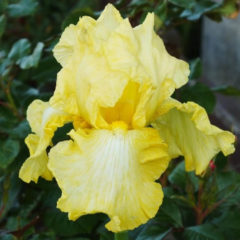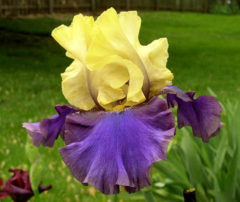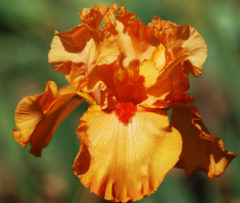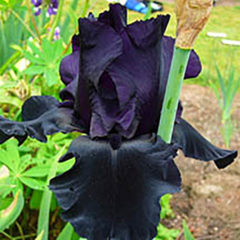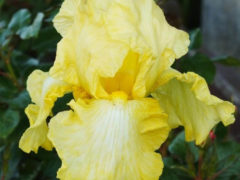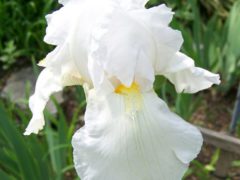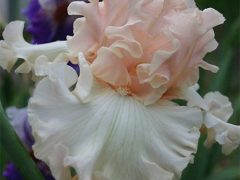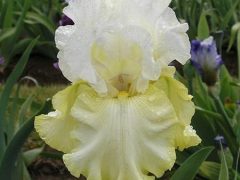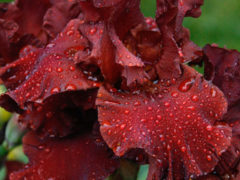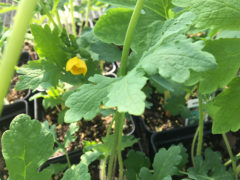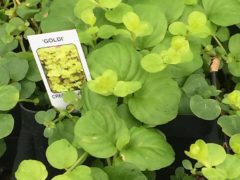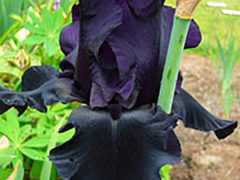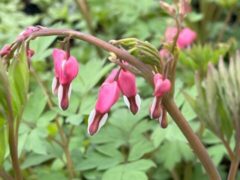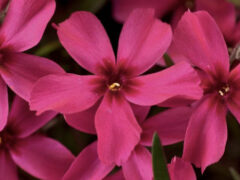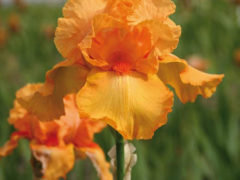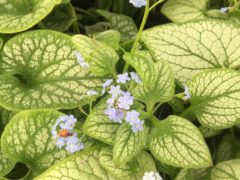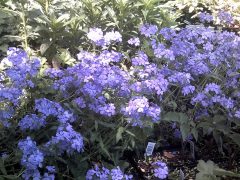Irises might just be the easiest perennial to grow. Plant them in full sun in the garden border or bed and they will grow without further help from anyone. Irises will also grow happily in shade but will produce fewer blooms. Plant iris rhizomes in spring through early fall to allow the roots to establish before the growing season ends. Choose a location with average to fertile, well-drained soil. After blooming, cut back flowering stalks but leave foliage intact to stimulate the growth for next season. The foliage makes a nice contrast with other perennials throughout the season even when plants are not blooming.
Irises bloom in spring or early summer, and a few rebloom in late summer and fall.
Here are four rebloomers:
Iris ‘Summer Olympics’ / ‘Harvest of Memories’
Iris germanica
Ruffled lime-yellow blooms are among the first to open in spring, and then bloom again throughout the summer! Slight sweet fragrance. German bearded iris are heirloom plants as tolerant and adaptable as they come. Spikey blue-green foliage makes an attractive show across three seasons, and spring blooms are a harbinger of the summer season to come. Break off seedpods that form after blooms have faded and prune back foliage in fall if desired. Some varieties rebloom in fall, and flowers bloom in a variety of striking colors! Plants can be divided every few years.
Iris ‘Immortality’
Iris germanica
Pure white blooms with a light lemon-yellow beard. Vigorous rebloomer. Fragrant. German bearded iris are heirloom plants as tolerant and adaptable as they come. Spikey blue-green foliage makes an attractive show across three seasons, and spring blooms are a harbinger of the summer season to come. Break off seedpods that form after blooms have faded and prune back foliage in fall if desired. Some varieties rebloom in fall, and flowers bloom in a variety of striking colors! Plants can be divided every few years.
Iris ‘Beverly Sills’
Iris germanica
One of the most sought-after tall bearded iris, blooms of the 'Beverly Sills' sport pale coral-pink petals and set off the light apricot beard. Watch these iris blooms return time after time with this rebloomer! German bearded iris are heirloom plants as tolerant and adaptable as they come. Spikey blue-green foliage makes an attractive show across three seasons, and spring blooms are a harbinger of the summer season to come. Break off seedpods that form after blooms have faded and prune back foliage in fall if desired. Some varieties rebloom in fall, and flowers bloom in a variety of striking colors! Plants can be divided every few years.
Iris ‘Buckwheat’
Iris germanica
Yellow fades to white at the center of standards surrounded by yellow falls. An early variety that reblooms. 31" tall. German bearded iris are heirloom plants as tolerant and adaptable as they come. Spikey blue-green foliage makes an attractive show across three seasons, and spring blooms are a harbinger of the summer season to come. Break off seedpods that form after blooms have faded and prune back foliage in fall if desired. Some varieties rebloom in fall, and flowers bloom in a variety of striking colors! Plants can be divided every few years.
Irises are available in many colors to pair with other spring-blooming plants.
Here are some combos to try:
Red and yellow!
Iris ‘War Chief’
Iris germanica
'War Chief' has been called one of the best red irises. With large, 6" velvety red/scarlet blooms that do not fade in the sun, this robust grower sports 8-9 flowers per stalk. German bearded iris are heirloom plants as tolerant and adaptable as they come. Spikey blue-green foliage makes an attractive show across three seasons, and spring blooms are a harbinger of the summer season to come. Break off seedpods that form after blooms have faded and prune back foliage in fall if desired. Some varieties rebloom in fall, and flowers bloom in a variety of striking colors! Plants can be divided every few years.
celandine, wood poppy
Stylophorum diphyllum
This woodland wildflower occurs most often in moist woodlands and along streams and features 4-petaled, yellow flowers which bloom in spring in small clusters atop stems 12-18" tall. Blue-green, interestingly lobed foliage is silvery below. Stems contain a bright yellow sap which was formerly used as a dye by Native Americans.
moneywort, golden creeping Jenny
Lysimachia nummularia
Round, green leaves create a low-growing mat with small yellow flowers. 'Aurea' is a bright chartreuse selection that spreads rapidly in moist locations, and also make fantastic trailing foliage plants in hanging baskets and containers. Will grow in sun or shade, but requires more moisture in sunnier locations.
Pink and black!
Iris ‘Black Water’ / ‘Superstition’
Iris germanica
Dramatic ruffles on inky, dark-colored blooms make a wonderful foil to brighter purple tones. Aromatic. German bearded iris are heirloom plants as tolerant and adaptable as they come. Spikey blue-green foliage makes an attractive show across three seasons, and spring blooms are a harbinger of the summer season to come. Break off seedpods that form after blooms have faded and prune back foliage in fall if desired. Some varieties rebloom in fall, and flowers bloom in a variety of striking colors! Plants can be divided every few years.
old-fashioned bleeding heart
Dicentra spectabilis
creeping phlox
Phlox subulata
Showy spring perennials produce vibrant carpets of bloom in very early spring, right when we're all starved for some color. Tolerates dry conditions once established. Perfect as an accent in a rock garden. Tumbles nicely over walls. 'Scarlet Flame' warms up spring with red, star-shaped flowers over creeping, needlelike, evergreen foliage. 'Purple Beauty' makes a luscious carpet of deep purple blooms in early spring. 'Eye Carumba' features medium pink flowers with a red eye. The 0.75" blooms are notably larger than typical Phlox subulata. 'Crimson Beauty' sports a sea of rosy-red blooms. 'Strawberries & Cream' is a hybrid selected primarily for its color change and long bloom season. Masses of nearly white, with a light violet-pink blush, broad-petaled flowers appear mid-spring and last for weeks. As the flowers mature they become medium to dark pink-violet giving the plant a two-toned look. A slightly larger and more vigorous grower selected from a cross of P. subulata and P. kelseyi.
Orange and blue!
Iris ‘Firebreather’
Iris germanica
Ruffled orange blossoms with vibrant beards the color of glowing embers add a warm presence to the June border. 'Firebreather' produces numerous blossoms per stem. An American Iris Society award winner. German bearded iris are heirloom plants as tolerant and adaptable as they come. Spikey blue-green foliage makes an attractive show across three seasons, and spring blooms are a harbinger of the summer season to come. Break off seedpods that form after blooms have faded and prune back foliage in fall if desired. Some varieties rebloom in fall, and flowers bloom in a variety of striking colors! Plants can be divided every few years.
Brunnera ‘Jack Frost’ bugloss
Brunnera macrophylla 'Jack Frost'
Perennial Plant Association 2012 Perennial Plant of the Year!
Foliage is intricately washed with a striking silver, crackle-like finish. Dark green leaves are heavily frosted which allows only the green veining to show through.
From mid to late spring, baby blue, blossoms that resemble forget-me-not are held in clusters over the shimmering foliage that brightens shady areas in borders or woodland settings or as a groundcover. A beautiful and low-maintenance addition to the shade garden.
wild sweet William
Phlox divaricata
Phlox divaricata and Phlox divaricata ‘Blue Moon’ grow clusters of blue and violet five-petal stars in early spring are sweetly scented. This woodland edge native naturalizes easily, and provides an early nectar source for hungry hummingbirds and bees! Grows to 1′ tall.
